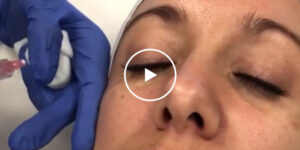During sunnier, warmer months, protecting against sun spots and hyperpigmentation is a hot topic …
but if you’ve been slathering on the SPF and shielding your skin from the sun’s rays and you’re still noticing dark patches of skin, you could be suffering from a different concern: melasma. Though melasma is characterised by dark ‘stains’ and pigmented areas on the skin, its causes and treatment methods can be more complex than those of sun exposure.
What Is Melasma?
Melasma is a common condition that features symmetrical, hyperpigmented patches on the skin. These patches typically appear on parts of the body that are prone to sun exposure such as the face, but they can develop in other areasas well.
Though hormonal pigmentation can affect anyone, women of reproductive age with darker skin types are the most common sufferers– due, in part, to the huge role that sex hormones play in the formation of melasma [1]. Often, women who develop melasma are pregnant (known as chloasma), taking an oral contraceptive pill or undergoing hormone replacement therapy, causing researchers to link the condition to certain circulating oestrogens.
These hormones certainly do not account for every case of melasma, and a number of risk factors seem to play a role in the development or recurrence of the disorder. Exposure to sunlight and sun-beds can trigger melasma, as well as medical conditions that affect hormone levels [2].
Treating Melasma
For many people, the noticeable nature of melasma can lead to self-consciousness, with some sufferers feeling the need to hide under layers of thick makeup. Melasma is not always easy to treat, but research has demonstrated that several approaches can help control the pigmentation.
Sunscreen
Protecting from harmful UV rays is an important part of preventing the initial development of melasma and any subsequent relapses [2]. Use a high SPF broad spectrum sunscreen paired with topical vitamin C and vitamin E for maximum protection from the sun.
Topical therapy
Different types and combinations of topical applications are often prescribed to treat melasma. These different products include hydroquinone, kojic acid and azelaic acid, and they have mixed reports of effectiveness. Combination treatments with hydroquinone, retinoic acid and a topical steroid are also common and show promising results [1].
Chemical peels
Chemical peels are another popular approach to treating melasma. At our skin clinic in London, we offer the PCA Peel, which combines trichloroacetic acid, retinoic acid, salicylic acid and L-ascorbic acid to address skin problems at a cellular level. The PCA Peel improves the tone, texture and clarity of the skin. It’s suitable for all skin types and ethnicities, and we often use it to reduce the appearance of melasma and other hyperpigmentation concerns.
Salicylic acid
The use of salicylic acid in peels for melasma treatment has been shown to be moderately effective, and more studies are currently in progress to determine its efficacy in other combinations and applications [1]. As described above, our VI Peel harnesses the power of salicylic acid against melasma.
In conjunction with powerful topical lotions, we may also recommend our HydraFacial treatment to improve the overall quality of your skin. The HydraFacial resurfaces the skin through a series of cleansing, exfoliating, hydrating and nourishing steps. We tailor the HydraFacial to your individual needs and can incorporate a salicylic acid peel into the treatment to help address melasma, which we follow with specially blended, antioxidant-rich serums to comprehensively cleanse, resurface and moisturise the skin.
Whether you want to learn more about how to distinguish melasma from sun damage or you’re ready for treatment, WY can provide the guidance you need. Our team of aesthetic professionals is experienced in the treatment of this condition – and though there is no cure-all for melasma, a carefully planned skincare regimen and course of treatments can help to reduce and control the condition.
REFERENCES
[1] https://www.prime-journal.com/melasma-aetiology-and-treatment-review/






